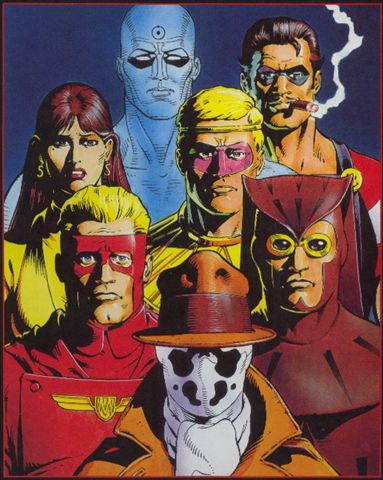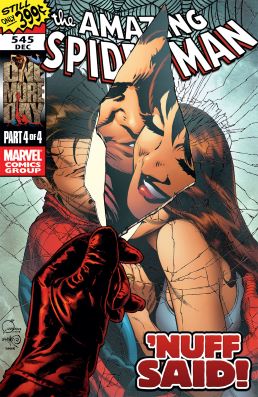To those of you still waiting for another fanfic out of me: sorry, but I still can’t seem to get one ready. So, since I still need to practice my writing, I’ve decided to do another article, this time about comic book continuity. It’s just something I’ve been aching to do for a while.
Mention “continuity” in any comics forum and odds are you’ll get at least one “not again!” reaction, and possibly even a full-scale flame war. Even some comic book professionals have posted how much they hate the term.
But why? What exactly is “comics continuity” and why is it such a controversial topic?
Let’s define the term first:
“Continuity” means keeping your facts straight from one story to another in serialized fiction- not just comics, but also TV shows, cartoons, movie sequels, novel series, etc. In short, everything that happens in one story is supposed to count for any other stories that come later in the series. The idea is to simulate reality, and to slowly build a particular “mythology” of their own- introducing new characters, changing or eliminating others, and so on. This is something most people understand and expect, since that’s how the real world works.
How is comic book continuity different? Well, for one thing, most comic book companies (in America anyway) have a tendency to establish continuity not just within specific series, but between others they also publish, effectively creating their own “fictional universes.” This also happens in other media, but comics are the most noted for this. In the case of Marvel and DC comics -the two leading American companies- almost EVERY series they publish is assumed to be part of their respective universes, no matter how unusual a combination that might make (Yes, Howard The Duck DOES exist in the same universe as Spider-Man… O.O ) Exceptions exist in both but are specifically singled out.
Another important factor is that comics continuity is OLD. While the continuity of say, a TV series, usually covers only that series, and a new version with no connection to the original can be introduced years later, American comics tend to use characters who are DECADES old, in some cases extending all the way back to the 1930’s!! As you can imagine, having to keep tabs on who did what when can get difficult when you not only have to keep an eye on dozens of other current comics, but also THOUSANDS of comics published over the course of 70 years, especially back when resources like the Internet didn’t exist! And yet, that’s exactly what Marvel and DC try to do (well, to an extent, as you’ll soon see.)
Let’s look at the history of comics and see how the obsession over continuity developed…
THE GOLDEN AGE
For some reason that I’ve never understood well (other than that it sounds cool) comics historians have divided the publication of American comics in “periods” named after the “Ages of Mankind” from Greek mythology. (In case you don’t know the myth, the human race supposedly originally existed in a era of perfection known as The Golden Age. Then afterwards came a not-so-good era known as The Silver Age. Then the even-less-good Bronze age and- you get the idea.) It should be noted that these “eras” refer mostly to superhero comics, since they’re the ones who ultimately came to dominate the American market, though there have always been other types of comics published, and some were even more popular than superheroes at given times.
The Golden Age of Comics stretches from its beginning -which can refer either to the actual beginning of comics publication, in the 1920s, or more usually, the publication of Action Comics #1, in 1938, where Superman, the first big-name superhero, debuted- to the early 1950s, where comic sales shrank greatly and most superhero comics were canceled.
Comics were originally just reprints of comic strips published in newspapers; as you can imagine, they were prominently humorous cartoons such as Popeye, with little continuity between them, although adventure serials such as Prince Valiant and The Phantom already existed. However, it wasn’t long before original material was being made for the comic books. Continuity existed only when a particular writer wanted to have it, and crossovers were hardly ever heard of. And sometimes even a particular series intentionally changed its continuity without explanation, as well. An example of this would be how Superman, only about two years after his origin, started to fly rather than just “leap over tall buildings in a single bound”. This was because the popular Radio Show version had Superman flying, so the comics version starting doing it as well, with no explanation of how.
In addition, comic companies operated on the assumption that their readers were only children, and that they would lose interest in comics in about five years or so; however, they also expected to have a new audience of kids by then, who would most likely have never heard of the stories they had published previously (since comics were intended, as shocking as it may be to modern collectors, as throwaway entertainment) and so they felt free to ignore older stories if they wished, and in some cases even reused older scripts whole with new art, thinking nobody would notice! And they were, in fact, correct in these assumptions… for the most part.
But it wasn’t long before someone realized that having two or more of their currently published characters interact could be greatly profitable.
The first “big” superhero team-up happened in Marvel Comics -not the company, which didn’t exist yet, but its predecessor, Timely Comics, which published a magazine called “Marvel Comics”. Two highly successful characters had premiered in this series: Namor the Sub-Mariner, who’s basically a superstrong Aquaman (though he actually precedes DC’s hero by about seven years) and The Human Torch (not the one from the Fantastic Four, but rather the original, an android with fire-based powers). Crossing them over was a no-brainer; not only were they appearing in the same magazine, but Namor was actually an antihero who attacked New York city for what he perceived were humanity’s crimes against the sea (never mind he was half-human himself.) So having a superhero based on New York (The Torch) defend the city from Namor was almost a given (especially if you throw the whole “water versus fire” symbolism in.) This might also have been the origin of the old tradition of having superheroes fight when they first meet for whatever reason.
The crossover was a hit, and soon other comics were doing team-ups as well. Establishing a “shared universe” in the process probably was an unintended effect of this, but still that was what effectively happened: from then on, it was fair to assume that every Submariner and Human Torch took place in the same world, even if there were no specific clues to it in the stories.
DC Comics (then known as National Periodical Publications) did Marvel one better, though, when they created the first superhero team: The Justice Society of America! Like the Namor/Human Torch crossover, the Society was formed by characters who happened to be published in the same title at the same time: The Flash, Hawkman, Hour-Man, the Spectre The Sandman, and others. Curiously, most of the early adventures of the Society had the heroes split off to investigate separate aspects of the same case, with very little time actually working together, which was almost as if they still were starring in their separate strips! Still, this was enough to establish that the heroes belonged in the same universe. Eventually, other superhero groups would also appear.

Overall, despite crossovers and team-ups, continuity simply wasn’t as big a deal in the Golden Age as it would become in later eras.
NEXT: THE SILVER AGE- DC goes wacky, while Marvel gets serious.









_1.jpg/300px-OHOTMU_(1983)_1.jpg)



.jpg)










 The problem comes when a company presents a continuity and then flagrantly violates it, as we saw DC did right after their big showy reboot. The reason for this is, simply put, poor editorship. One of your jobs as an editor in a complex entertainment company -which is what comics are- is to make sure that what your writers produce doesn’t contradict what has gone before, or more importantly, what is going on in other comics that are also being published
The problem comes when a company presents a continuity and then flagrantly violates it, as we saw DC did right after their big showy reboot. The reason for this is, simply put, poor editorship. One of your jobs as an editor in a complex entertainment company -which is what comics are- is to make sure that what your writers produce doesn’t contradict what has gone before, or more importantly, what is going on in other comics that are also being published